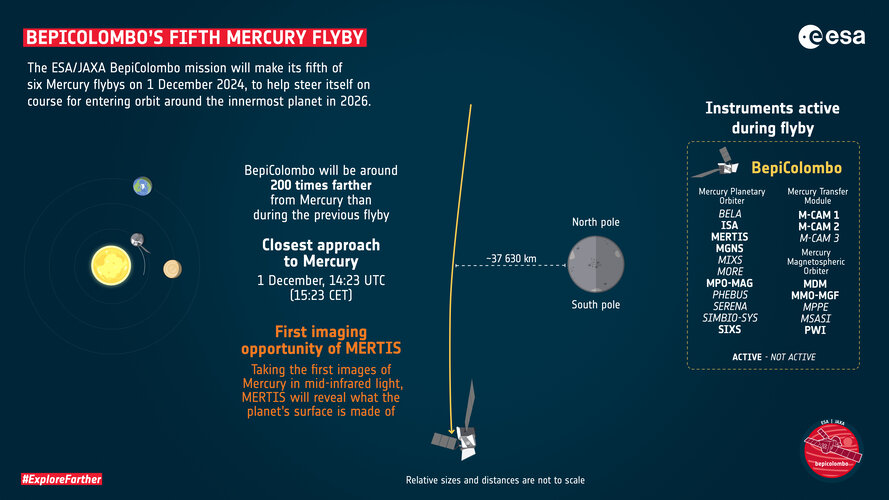China launches first Long March 12 from new commercial spaceport in boost for country’s lunar plans
Saturday, 30 November 2024 14:48
Lockheed Martin unveils solar power array for Artemis program
Saturday, 30 November 2024 14:24

'Marching orders haven't changed': New Artemis mobile launcher takes shape amid uncertain future
Saturday, 30 November 2024 03:40This request seems a bit unusual, so we need to confirm that you're human. Please press and hold the button until it turns completely green. Thank you for your cooperation!
Press and hold the button
If you believe this is an error, please contact our support team.
185.132.36.159 : a2d9fbe9-6f93-4f75-ada1-dcb54b20
Space Force awards Raytheon $196.7 million for additional work on GPS ground control system
Friday, 29 November 2024 13:58

BepiColombo's fifth Mercury flyby
Friday, 29 November 2024 13:30 Image:
BepiColombo's fifth Mercury flyby
Image:
BepiColombo's fifth Mercury flyby Watch live: Vega-C to launch Sentinel-1C
Friday, 29 November 2024 13:15
The Copernicus Sentinel-1C satellite is ready for liftoff! Tune in to ESA WebTV on 4 December from 22:00 CET to watch the satellite soar into space on a Vega-C rocket to be launched from Europe’s Spaceport in Kourou, French Guiana. Sentinel-1C is scheduled to liftoff at 22:20 CET.
Week in images: 25-29 November 2024
Friday, 29 November 2024 13:10
Week in images: 25-29 November 2024
Discover our week through the lens
Astroscale approaches critical design review for OneWeb de-orbit mission
Friday, 29 November 2024 09:00

Earth from Space: Agricultural patchwork, Romania
Friday, 29 November 2024 08:00 Image:
A colourful patchwork of agricultural fields is pictured in this radar image captured by Copernicus Sentinel-1 over southeastern Romania.
Image:
A colourful patchwork of agricultural fields is pictured in this radar image captured by Copernicus Sentinel-1 over southeastern Romania. Zenno Astronautics gains support from Japanese space leaders in latest funding round
Friday, 29 November 2024 02:43 New Zealand-headquartered Zenno Astronautics has announced the initial close of its seed expansion funding round, marking a major milestone for the space-focused superconductor company. The round was led by New Zealand's Global From Day One (GD1), with notable contributions from Shasta Ventures and existing backers such as Nuance, K1W1, UniServices, NZVC, and New Zealand Growth Capital Partners
New Zealand-headquartered Zenno Astronautics has announced the initial close of its seed expansion funding round, marking a major milestone for the space-focused superconductor company. The round was led by New Zealand's Global From Day One (GD1), with notable contributions from Shasta Ventures and existing backers such as Nuance, K1W1, UniServices, NZVC, and New Zealand Growth Capital Partners SatVu receives major funding to advance thermal imaging capabilities
Friday, 29 November 2024 02:43 SatVu, a prominent climate technology innovator, has secured Pounds 20 million in funding to propel its advanced high-resolution thermal imaging technology. The funding consists of a Pounds 10 million equity round led jointly by Adara Ventures and existing backer Molten Ventures, alongside an insurance payout.
This investment marks the debut of Adara Ventures Energy Fund, dedicated to su
SatVu, a prominent climate technology innovator, has secured Pounds 20 million in funding to propel its advanced high-resolution thermal imaging technology. The funding consists of a Pounds 10 million equity round led jointly by Adara Ventures and existing backer Molten Ventures, alongside an insurance payout.
This investment marks the debut of Adara Ventures Energy Fund, dedicated to su Commercial Earth Observation to exceed $8 billion by 2033
Friday, 29 November 2024 02:43 The commercial Earth Observation (EO) market is forecasted to experience substantial growth, according to the latest Earth Observation Data and Services Market report from Novaspace. Currently valued at $5 billion, the market is projected to surpass $8 billion by 2033. The services segment is expected to grow from $3.1 billion to $4.9 billion during the same period.
The report attributes t
The commercial Earth Observation (EO) market is forecasted to experience substantial growth, according to the latest Earth Observation Data and Services Market report from Novaspace. Currently valued at $5 billion, the market is projected to surpass $8 billion by 2033. The services segment is expected to grow from $3.1 billion to $4.9 billion during the same period.
The report attributes t McGill Professor leads AXIS mission in final phase of NASA selection process
Friday, 29 November 2024 02:43 NASA has advanced the Advanced X-ray Imaging Satellite (AXIS) mission, co-led by McGill University's Professor Daryl Haggard, to the final selection phase of its $1 billion space probe competition.
The AXIS mission seeks to explore the origins of primordial black holes from the early universe, investigating their formation and influence on galaxy evolution. It will also study explosive phe
NASA has advanced the Advanced X-ray Imaging Satellite (AXIS) mission, co-led by McGill University's Professor Daryl Haggard, to the final selection phase of its $1 billion space probe competition.
The AXIS mission seeks to explore the origins of primordial black holes from the early universe, investigating their formation and influence on galaxy evolution. It will also study explosive phe How do radar satellites work?
Thursday, 28 November 2024 14:20 Video:
00:07:33
Video:
00:07:33
Radar allows us to see through what would otherwise be invisible. By sending out radio waves that bounce off objects and return as echoes, radar creates a detailed picture of our surrounding world.
This technology is everywhere: from guiding air traffic and enabling self-driving cars to tracking the movements of athletes. But its reach doesn’t stop there—radar is also transforming how we observe our Earth from space.
Satellites like the Copernicus Sentinel-1 mission use radar to see through clouds, darkness and any weather conditions. This capability is invaluable for detecting subtle changes on Earth’s surface—changes that are often hidden



